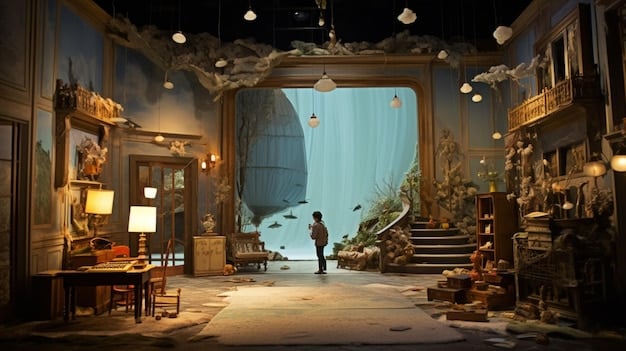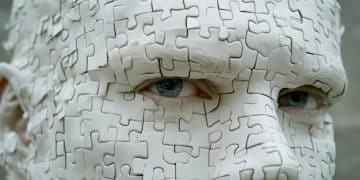Unlock Your Memory: Mastering Memory Palaces for Enhanced Recall

Memory Palaces, also known as the method of loci, are powerful mnemonic devices that enhance recall of information by creating a mental map of a familiar location and associating items to be remembered with specific locations within that space.
Imagine effortlessly recalling complex information, from historical facts to shopping lists. The technique of **memory palaces: create a mental map for enhanced recall of information** is a powerful tool that can help you do just that.
What are Memory Palaces?
Memory palaces, also known as the method of loci, are a mnemonic device dating back to ancient Greece. This technique involves creating a mental “place” that you know well, and then “placing” information you want to remember at specific locations within that place.
By mentally “walking” through your memory palace, you can retrieve the information by recalling the objects or images you associated with each location.
The History of Memory Palaces
The earliest known description of the method of loci is attributed to Simonides of Ceos, an ancient Greek poet. Legend has it that he was able to identify the bodies of guests who had been crushed in a building collapse by remembering where each guest had been sitting.
This event highlighted the power of associating information with specific locations, laying the foundation for what would become one of the most enduring mnemonic techniques.
How Memory Palaces Work
The effectiveness of memory palaces relies on the brain’s natural ability to remember spatial information. By converting abstract information into visual and spatial cues, you tap into the brain’s visual and spatial memory systems.
This makes the information more engaging and easier to recall, as the brain processes visual and spatial memories more effectively than abstract data.
- Visualization: Creating vivid images and mental scenarios.
- Association: Linking new information with familiar locations.
- Narration: Developing stories to connect different elements in the palace.

In summary, memory palaces utilize the brain’s spatial memory abilities to provide a coherent and engaging way to remember information.
Why Use Memory Palaces?
Using a memory palace can significantly improve your recall abilities. Whether you’re a student, professional, or simply someone looking to enhance your memory, this technique offers numerous benefits.
The method provides a structured and organized approach to remembering complex information, making it an invaluable tool.
Enhanced Recall
Memory palaces improve recall by linking information to specific locations in a familiar space. This makes retrieving the information smoother and more natural, as the brain recalls both the location and the information associated with it.
This technique allows for precise storage and recall of information in a way that linear memorization often fails to achieve.
Improved Focus
Constructing and navigating a **memory palace** requires intense focus and concentration. This mental exercise sharpens your attention span and enhances your ability to focus on the task at hand.
By engaging actively in creating and using the memory palace, you train your mind to be more attentive and less prone to distractions.
Creative Thinking
Memory palaces encourage creative thinking by prompting you to create imaginative scenarios and visualize them within your mental space. This process stimulates creativity and makes learning more engaging.
The more imaginative and vivid your associations, the easier the information will be to remember, thus fostering creativity.
- Engage visual and spatial memory
- Improves focus and organization
- A fun and engaging memory technique
In conclusion, memory palaces offer a range of cognitive benefits, from enhanced recall to improved focus and creative thinking, making it a valuable tool.
How to Build Your Own Memory Palace
Creating your own memory palace is easier than you might think. The key is to choose a place you know well and follow a structured approach to populate it with the information you want to remember.
This section will guide you through the steps of building an effective memory palace.
Choose a Familiar Location
The first step in building a memory palace is to select a familiar location. This could be your home, your route to work, or any place you know intimately.
The more familiar you are with the location, the easier it will be to navigate it mentally and recall the associated information.
Identify Distinct Locations
Once you’ve chosen your location, identify distinct locations or “loci” within it. These could be specific objects, landmarks, or rooms.
The more distinct and memorable each location is, the better it will serve as an anchor for the information you want to remember.
Associate Information with Locations
Now comes the creative part: associating the information you want to remember with the locations you’ve identified. The more vivid, unusual, and engaging the associations, the easier it will be to recall them.
Use your imagination to create memorable connections between the information and the locations in your memory palace.

In summary, building a memory palace involves selecting a familiar location, identifying distinct locations within it, and associating the information you want to remember with those locations.
Tips for an Effective Memory Palace
Building a memory palace is only the beginning. To make the most of this technique, consider these tips to enhance its effectiveness.
These tips will help you create a memory palace that is both memorable and efficient.
Use Vivid Imagery
The more vivid and unusual your images, the easier they will be to remember. Don’t be afraid to get creative and imagine bizarre or humorous scenarios.
The more memorable and striking the images, the stronger the association between the location and the information.
Space Out Your Learning
Instead of trying to populate your memory palace all at once, spread out your learning over time. This technique, known as spaced repetition, improves long-term retention.
Reviewing the information at increasing intervals helps reinforce the connections in your memory palace.
Use Multiple Senses
Engage as many senses as possible when creating your associations. Think about how the information looks, sounds, smells, tastes, and feels.
The more sensory information you incorporate, the richer and more memorable the experience will be, enhancing the effectiveness of your **memory palace**.
- Use vivid and unusual imagery
- Space out learning over time
- Incorporate multiple senses
To summarize, using vivid imagery, spacing out your learning, and incorporating multiple senses can significantly enhance the effectiveness of your memory palace.
Examples of Memory Palace Applications
Memory palaces can be used in a wide variety of contexts, from academic studies to professional development. Here are a few examples to illustrate their versatility.
These examples demonstrate how memory palaces can be adapted to suit different learning and memory needs.
Studying for Exams
Students can use memory palaces to remember key concepts, formulas, and facts for exams. By associating specific pieces of information with locations in their memory palace, they can quickly recall the necessary details during the test.
This technique allows students to organize and retrieve information in a practical and efficient manner.
Learning Languages
Memory palaces can be incredibly helpful for learning new vocabulary and grammar rules. By associating words and phrases with objects or locations in their memory palace, language learners can reinforce their knowledge and improve recall.
This approach provides a visual and spatial context for language learning, making it more engaging and effective.
Public Speaking
Speakers can use memory palaces to remember the key points of their speeches. By placing each point at a specific location in their memory palace, they can ensure a smooth and coherent delivery, without relying on notes.
This method helps speakers maintain eye contact with the audience and speak with greater confidence and fluency.
In conclusion, memory palaces can be applied in various settings, including studying, learning languages, and public speaking, demonstrating their adaptability.
Common Mistakes to Avoid
While memory palaces are a powerful mnemonic technique, they can be ineffective if not used correctly. Here are some common mistakes to avoid when building and using memory palaces.
Avoiding these mistakes will help you use memory palaces more effectively and maximize their benefits.
Choosing an Unfamiliar Location
One of the most common mistakes is choosing a location that is not familiar enough. The more familiar you are with the location, the easier it will be to navigate it mentally and recall the associated information.
This is a critical feature to ensure proper function of the memory palace recall ability.
Overcrowding Your Palace
Trying to cram too much information into a single location can lead to confusion and decreased recall. It’s better to spread out the information and use multiple locations.
This allows you to keep separate the different concepts.
Not Reviewing Regularly
Memory palaces require regular review to maintain their effectiveness. If you don’t revisit your palace and reinforce the associations, the information may fade over time.
This helps to maintain long-term memory of the concept.
| Key Point | Brief Description |
|---|---|
| 🧠 Enhanced Recall | Links information to specific locations. |
| 📍 Familiar Location | Use a well-known place for easier navigation. |
| 🖼️ Vivid Imagery | Create unusual and memorable associations. |
| 📚 Regular Review | Revisit your memory palace to reinforce memories. |
Frequently Asked Questions
▼
A familiar place is best, like your home or a route you often travel. The key is knowing the space well so you can easily navigate it mentally.
▼
Start with a manageable number, like 10-20 distinct locations. You can always expand it later as you become more comfortable with the technique.
▼
Yes, but it’s best to clear the palace after you no longer need the information to avoid confusion. Or, create multiple palaces for different subjects.
▼
Regularly! Especially in the beginning, try to mentally walk through it daily. As the associations become stronger, you can reduce the frequency.
▼
Don’t panic! Try to recall the surrounding associations or retrace your steps within the palace. If all else fails, recreate the association with a stronger image.
Conclusion
The method of **memory palaces: create a mental map for enhanced recall of information** is a powerful technique to improve memory and cognitive functions. Begin creating your own memory palace today!





